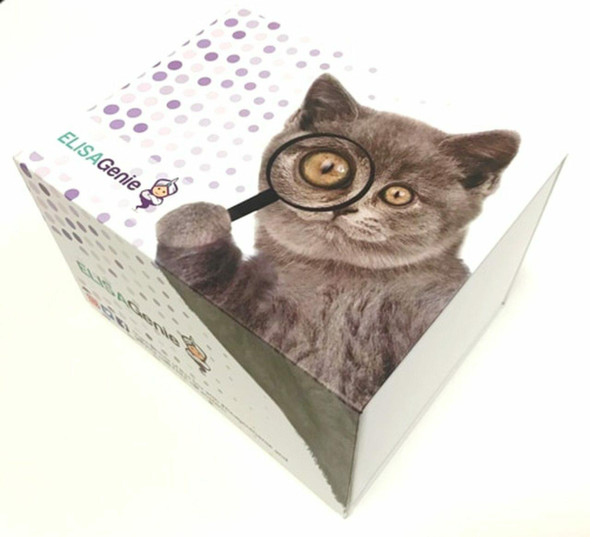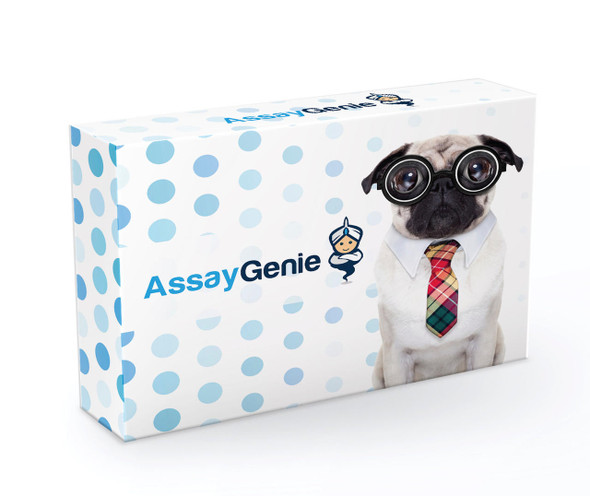Description
Rat Dipeptidyl peptidase 4 (Dpp4) ELISA Kit
The Rat Dipeptidyl Peptidase-4 (DPP4) ELISA Kit is a powerful tool for the precise measurement of DPP4 levels in rat samples, including serum, plasma, and tissue lysates. With its high sensitivity and specificity, this kit ensures accurate and reproducible results, making it ideal for a variety of research applications.Dipeptidyl Peptidase-4 is an enzyme involved in the regulation of glucose metabolism, inflammation, and immune response. Its dysregulation has been implicated in conditions such as diabetes, obesity, and cardiovascular diseases, making it a valuable biomarker for studying these diseases and exploring potential therapeutic interventions.
Overall, the Rat DPP4 ELISA Kit offers researchers a reliable and efficient way to assess DPP4 levels in rat samples, facilitating in-depth investigations into its role in various disease processes and the development of novel treatment strategies.
| Product Name: | Rat Dipeptidyl peptidase 4 (Dpp4) ELISA Kit |
| SKU: | RTEB0501 |
| Size: | 96T |
| Target: | Rat Dipeptidyl peptidase 4 (Dpp4) |
| Synonyms: | Bile canaliculus domain-specific membrane glycoprotein, Dipeptidyl peptidase IV, GP110 glycoprotein, T-cell activation antigen CD26, DPP IV, CD26, Cd26 |
| Assay Type: | Sandwich |
| Detection Method: | ELISA |
| Reactivity: | Rat |
| Detection Range: | 0.156-10ng/ml |
| Sensitivity: | 0.082ng/mL |
| Intra CV: | 4.4% | ||||||||||||||||||||
| Inter CV: | 8.9% | ||||||||||||||||||||
| Linearity: |
| ||||||||||||||||||||
| Recovery: |
| ||||||||||||||||||||
| Function: | Cell surface glycoprotein receptor involved in the costimulatory signal essential for T-cell receptor (TCR)-mediated T-cell activation. Acts as a positive regulator of T-cell coactivation, by binding at least ADA, CAV1, IGF2R, and PTPRC. Its binding to CAV1 and CARD11 induces T-cell proliferation and NF-kappa-B activation in a T-cell receptor/CD3-dependent manner. Its interaction with ADA also regulates lymphocyte-epithelial cell adhesion. In association with FAP is involved in the pericellular proteolysis of the extracellular matrix (ECM), the migration and invasion of endothelial cells into the ECM. May be involved in the promotion of lymphatic endothelial cells adhesion, migration and tube formation. When overexpressed, enhanced cell proliferation, a process inhibited by GPC3. Acts also as a serine exopeptidase with a dipeptidyl peptidase activity that regulates various physiological processes by cleaving peptides in the circulation, including many chemokines, mitogenic growth factors, neuropeptides and peptide hormones. Removes N-terminal dipeptides sequentially from polypeptides having unsubstituted N-termini provided that the penultimate residue is proline. |
| Uniprot: | P14740 |
| Sample Type: | Serum, plasma, tissue homogenates, cell culture supernates and other biological fluids |
| Specificity: | Natural and recombinant rat Dipeptidyl peptidase 4 |
| Sub Unit: | Monomer. Homodimer. Heterodimer with Seprase (FAP). Requires homodimerization for optimal dipeptidyl peptidase activity and T-cell costimulation. Found in a membrane raft complex, at least composed of BCL10, CARD11, DPP4 and IKBKB. Associates with collagen. Interacts with PTPRC; the interaction is enhanced in a interleukin-12-dependent manner in activated lymphocytes. Interacts (via extracellular domain) with ADA; does not inhibit its dipeptidyl peptidase activity. Interacts with CAV1 (via the N-terminus); the interaction is direct. Interacts (via cytoplasmic tail) with CARD11 (via PDZ domain); its homodimerization is necessary for interaction with CARD11. Interacts with IGF2R; the interaction is direct. Interacts with GPC3. |
| Research Area: | Immunology |
| Subcellular Location: | Cell membrane Single-pass type II membrane protein Apical cell membrane Single-pass type II membrane protein Cell projection Invadopodium membrane Single-pass type II membrane protein Cell projection Lamellipodium membrane Single-pass type II membrane protein Cell junction Membrane raft Translocated to the apical membrane through the concerted action of N- and O-Glycans and its association with lipid microdomains containing cholesterol and sphingolipids. Redistributed to membrane rafts in T-cell in a interleukin-12-dependent activation. Its interaction with CAV1 is necessary for its translocation to membrane rafts. Colocalized with PTPRC in membrane rafts. Colocalized with FAP in invadopodia and lamellipodia of migratory activated endothelial cells in collagenous matrix. Colocalized with FAP on endothelial cells of capillary-like microvessels but not large vessels within invasive breast ductal carcinoma. Colocalized with ADA at the cell junction in lymphocyte-epithelial cell adhesion. Colocalized with IGF2R in internalized cytoplasmic vesicles adjacent to the cell surface (By similarity). |
| Storage: | Please see kit components below for exact storage details |
| Note: | For research use only |
| UniProt Protein Function: | DPP4: Cell surface glycoprotein receptor involved in the costimulatory signal essential for T-cell receptor (TCR)-mediated T-cell activation. Acts as a positive regulator of T-cell coactivation, by binding at least ADA, CAV1, IGF2R, and PTPRC. Its binding to CAV1 and CARD11 induces T-cell proliferation and NF- kappa-B activation in a T-cell receptor/CD3-dependent manner. Its interaction with ADA also regulates lymphocyte-epithelial cell adhesion. In association with FAP is involved in the pericellular proteolysis of the extracellular matrix (ECM), the migration and invasion of endothelial cells into the ECM. May be involved in the promotion of lymphatic endothelial cells adhesion, migration and tube formation. When overexpressed, enhanced cell proliferation, a process inhibited by GPC3. Acts also as a serine exopeptidase with a dipeptidyl peptidase activity that regulates various physiological processes by cleaving peptides in the circulation, including many chemokines, mitogenic growth factors, neuropeptides and peptide hormones. Removes N-terminal dipeptides sequentially from polypeptides having unsubstituted N-termini provided that the penultimate residue is proline. Belongs to the peptidase S9B family. DPPIV subfamily. |
| UniProt Protein Details: | Protein type:Motility/polarity/chemotaxis; Endoplasmic reticulum; Cell surface; Cell adhesion; Membrane protein, integral; Protease; Cell cycle regulation; Vesicle; EC 3.4.14.5 Cellular Component: Golgi apparatus; intercellular canaliculus; cell surface; focal adhesion; endoplasmic reticulum; lysosomal membrane; integral to membrane; extracellular region; lipid raft; membrane; lamellipodium; endocytic vesicle; apical plasma membrane; plasma membrane; cell junction Molecular Function:collagen binding; identical protein binding; protein homodimerization activity; protease binding; serine-type peptidase activity; dipeptidyl-peptidase activity; serine-type endopeptidase activity; peptide binding; receptor binding Biological Process: regulation of cell-cell adhesion mediated by integrin; behavioral fear response; T cell activation; establishment of localization; regulation of T cell mediated immunity; positive regulation of cell proliferation; T cell costimulation; response to hypoxia; endothelial cell migration; cell adhesion; proteolysis |
| NCBI Summary: | catalyzes the degradation of glucagon-like peptide-1 (Glp-1); involved in proteolysis and peptidolysis [RGD, Feb 2006] |
| UniProt Code: | P14740 |
| NCBI GenInfo Identifier: | 56405289 |
| NCBI Gene ID: | 25253 |
| NCBI Accession: | P14740.2 |
| UniProt Related Accession: | P14740 |
| Molecular Weight: | 88,089 Da |
| NCBI Full Name: | Dipeptidyl peptidase 4 |
| NCBI Synonym Full Names: | dipeptidylpeptidase 4 |
| NCBI Official Symbol: | Dpp4 |
| NCBI Official Synonym Symbols: | CD26; DPPIV |
| NCBI Protein Information: | dipeptidyl peptidase 4; DPP IV; GP110 glycoprotein; dipeptidyl peptidase IV; T-cell activation antigen CD26; bile canaliculus domain-specific membrane glycoprotein |
| UniProt Protein Name: | Dipeptidyl peptidase 4 |
| UniProt Synonym Protein Names: | Bile canaliculus domain-specific membrane glycoprotein; Dipeptidyl peptidase IV; DPP IV; GP110 glycoprotein; T-cell activation antigen CD26; CD_antigen: CD26Cleaved into the following 3 chains:Dipeptidyl peptidase 4 membrane formAlternative name(s):Dipeptidyl peptidase IV membrane form |
| Protein Family: | Dipeptidyl peptidase |
| UniProt Gene Name: | Dpp4 |
| UniProt Entry Name: | DPP4_RAT |
| Component | Quantity (96 Assays) | Storage |
| ELISA Microplate (Dismountable) | 8×12 strips | -20°C |
| Lyophilized Standard | 2 | -20°C |
| Sample Diluent | 20ml | -20°C |
| Assay Diluent A | 10mL | -20°C |
| Assay Diluent B | 10mL | -20°C |
| Detection Reagent A | 120µL | -20°C |
| Detection Reagent B | 120µL | -20°C |
| Wash Buffer | 30mL | 4°C |
| Substrate | 10mL | 4°C |
| Stop Solution | 10mL | 4°C |
| Plate Sealer | 5 | - |
Other materials and equipment required:
- Microplate reader with 450 nm wavelength filter
- Multichannel Pipette, Pipette, microcentrifuge tubes and disposable pipette tips
- Incubator
- Deionized or distilled water
- Absorbent paper
- Buffer resevoir
*Note: The below protocol is a sample protocol. Protocols are specific to each batch/lot. For the correct instructions please follow the protocol included in your kit.
Allow all reagents to reach room temperature (Please do not dissolve the reagents at 37°C directly). All the reagents should be mixed thoroughly by gently swirling before pipetting. Avoid foaming. Keep appropriate numbers of strips for 1 experiment and remove extra strips from microtiter plate. Removed strips should be resealed and stored at -20°C until the kits expiry date. Prepare all reagents, working standards and samples as directed in the previous sections. Please predict the concentration before assaying. If values for these are not within the range of the standard curve, users must determine the optimal sample dilutions for their experiments. We recommend running all samples in duplicate.
| Step | |
| 1. | Add Sample: Add 100µL of Standard, Blank, or Sample per well. The blank well is added with Sample diluent. Solutions are added to the bottom of micro ELISA plate well, avoid inside wall touching and foaming as possible. Mix it gently. Cover the plate with sealer we provided. Incubate for 120 minutes at 37°C. |
| 2. | Remove the liquid from each well, don't wash. Add 100µL of Detection Reagent A working solution to each well. Cover with the Plate sealer. Gently tap the plate to ensure thorough mixing. Incubate for 1 hour at 37°C. Note: if Detection Reagent A appears cloudy warm to room temperature until solution is uniform. |
| 3. | Aspirate each well and wash, repeating the process three times. Wash by filling each well with Wash Buffer (approximately 400µL) (a squirt bottle, multi-channel pipette,manifold dispenser or automated washer are needed). Complete removal of liquid at each step is essential. After the last wash, completely remove remaining Wash Buffer by aspirating or decanting. Invert the plate and pat it against thick clean absorbent paper. |
| 4. | Add 100µL of Detection Reagent B working solution to each well. Cover with the Plate sealer. Incubate for 60 minutes at 37°C. |
| 5. | Repeat the wash process for five times as conducted in step 3. |
| 6. | Add 90µL of Substrate Solution to each well. Cover with a new Plate sealer and incubate for 10-20 minutes at 37°C. Protect the plate from light. The reaction time can be shortened or extended according to the actual color change, but this should not exceed more than 30 minutes. When apparent gradient appears in standard wells, user should terminatethe reaction. |
| 7. | Add 50µL of Stop Solution to each well. If color change does not appear uniform, gently tap the plate to ensure thorough mixing. |
| 8. | Determine the optical density (OD value) of each well at once, using a micro-plate reader set to 450 nm. User should open the micro-plate reader in advance, preheat the instrument, and set the testing parameters. |
| 9. | After experiment, store all reagents according to the specified storage temperature respectively until their expiry. |
When carrying out an ELISA assay it is important to prepare your samples in order to achieve the best possible results. Below we have a list of procedures for the preparation of samples for different sample types.
| Sample Type | Protocol |
| Serum | If using serum separator tubes, allow samples to clot for 30 minutes at room temperature. Centrifuge for 10 minutes at 1,000x g. Collect the serum fraction and assay promptly or aliquot and store the samples at -80°C. Avoid multiple freeze-thaw cycles. If serum separator tubes are not being used, allow samples to clot overnight at 2-8°C. Centrifuge for 10 minutes at 1,000x g. Remove serum and assay promptly or aliquot and store the samples at -80°C. Avoid multiple freeze-thaw cycles. |
| Plasma | Collect plasma using EDTA or heparin as an anticoagulant. Centrifuge samples at 4°C for 15 mins at 1000 × g within 30 mins of collection. Collect the plasma fraction and assay promptly or aliquot and store the samples at -80°C. Avoid multiple freeze-thaw cycles. Note: Over haemolysed samples are not suitable for use with this kit. |
| Urine & Cerebrospinal Fluid | Collect the urine (mid-stream) in a sterile container, centrifuge for 20 mins at 2000-3000 rpm. Remove supernatant and assay immediately. If any precipitation is detected, repeat the centrifugation step. A similar protocol can be used for cerebrospinal fluid. |
| Cell culture supernatant | Collect the cell culture media by pipette, followed by centrifugation at 4°C for 20 mins at 1500 rpm. Collect the clear supernatant and assay immediately. |
| Cell lysates | Solubilize cells in lysis buffer and allow to sit on ice for 30 minutes. Centrifuge tubes at 14,000 x g for 5 minutes to remove insoluble material. Aliquot the supernatant into a new tube and discard the remaining whole cell extract. Quantify total protein concentration using a total protein assay. Assay immediately or aliquot and store at ≤ -20 °C. |
| Tissue homogenates | The preparation of tissue homogenates will vary depending upon tissue type. Rinse tissue with 1X PBS to remove excess blood & homogenize in 20ml of 1X PBS (including protease inhibitors) and store overnight at ≤ -20°C. Two freeze-thaw cycles are required to break the cell membranes. To further disrupt the cell membranes you can sonicate the samples. Centrifuge homogenates for 5 mins at 5000xg. Remove the supernatant and assay immediately or aliquot and store at -20°C or -80°C. |
| Tissue lysates | Rinse tissue with PBS, cut into 1-2 mm pieces, and homogenize with a tissue homogenizer in PBS. Add an equal volume of RIPA buffer containing protease inhibitors and lyse tissues at room temperature for 30 minutes with gentle agitation. Centrifuge to remove debris. Quantify total protein concentration using a total protein assay. Assay immediately or aliquot and store at ≤ -20 °C. |
| Breast Milk | Collect milk samples and centrifuge at 10,000 x g for 60 min at 4°C. Aliquot the supernatant and assay. For long term use, store samples at -80°C. Minimize freeze/thaw cycles. |










